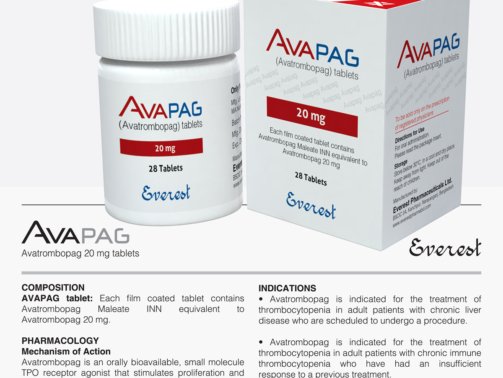Capmatinib 200 mg (Tabrecta)
0.00$
Cabani (Capmatinib) 200 mg is a medication used in the treatment of metastatic non-small cell lung cancer (NSCLC) with specific genetic mutations. It belongs to a class of drugs known as kinase inhibitors, which work by blocking the activity of certain proteins involved in cancer cell growth and proliferation. Cabani 200 mg is particularly effective in targeting tumors with alterations in the MET gene, offering a promising therapeutic option for patients with this subtype of NSCLC.
Capmatinib is a targeted oral drug used to treat certain types of non-small cell lung cancer (NSCLC). This kinase inhibitor specifically targets a protein that is essential for cell formation and proliferation: the mesenchymal-epithelial transition (MET) factor. Under the Tabrecta brand, which is manufactured by Novartis, the 200 mg dosage is an often advised strength and is available as film-coated tablets.
Mechanism of Action
Capmatinib inhibits the MET receptor tyrosine kinase through its MET inhibitory action. MET gene abnormalities, such as exon 14 skipping mutations, cause unchecked cell proliferation and cancer progression in certain NSCLC patients. via preventing tumor development and perhaps causing cancer cell death, capmatinib slows the progression of the disease via blocking MET.
Indications and Uses
Capmatinib 200 mg is mainly used to treat individuals with MET exon 14 skipping mutations who have metastatic non-small cell lung cancer. Capmatinib has been approved by the FDA and other regulatory agencies for this particular indication in the United States due to clinical trials that have shown notable tumor response rates.
Dosage and Administration
Suggested Dosage: 400 mg (two 200 mg tablets) should be taken twice a day, with or without meals.
Tablet Form: Capmatinib 200 mg comes in an oval-shaped, yellow tablet with a film coating.
Instructions for Administration: Do not chew, crush, or break the tablets; instead, drink them whole with water. Patients should take any missing doses as soon as possible, unless the next regular dose is almost due.
Pharmacokinetics
Absorption: Within 1-2 hours, capmatinib reaches its peak plasma levels due to its fast absorption.
Metabolism: The liver’s CYP3A4 enzyme is principally responsible for the drug’s metabolism.
Elimination: It is mostly eliminated by urine (8%), and feces (80%), with an elimination half-life of roughly 6 hours.
Side Effects and Safety Profile
Common adverse effects of Capmatinib 200 mg include:
Digestive issues, including nausea, vomiting, and diarrhea.
Fatigue: Exhaustion and low vitality
Hand and leg swelling is known as peripheral edema.
Abnormalities in Liver Function: Increased AST and ALT levels
Issues with the respiratory system: dyspnea
Skin Reactions: itching, or pruritus
Warnings and Precautions
Liver Toxicity: It is advised to get regular liver function tests.
If a patient has interstitial lung disease (ILD) or pneumonia, they should report any new or worsening coughing or breathing problems.
Drug Interactions: Capmatinib interacts with potent CYP3A4 inducers and inhibitors, which can change the amount of the drug.
Due to the possibility of fetal damage, it is not advised for use by women who are pregnant or nursing.
Conclusion
For patients with NSCLC who have MET exon 14 mutations, capmatinib 200 mg is an essential targeted treatment. Despite its great effectiveness, it necessitates close observation for adverse effects and drug interactions. A healthcare provider should always be consulted before beginning treatment.
Order Now At Mdx Pharma bd….
To order from MDX Pharma BD, visit their website at https://mdxpharmabd.com, where you can browse products and place orders online. For inquiries or orders via email, contact emedicarepharma@gmail.com. Alternatively, call (+88) 01929123476. Their address is 29, Abdullahpur, Uttara, Dhaka-1230, Bangladesh.
1. What is the purpose of the medication capmatinib?
A specific kind of non-small cell lung cancer (NSCLC) that has metastasized to other body parts is treated with capmatinib. Capmatinib belongs to a group of drugs known as kinase inhibitors. It functions by preventing an aberrant protein that instructs cancer cells to proliferate from doing its job.
2. What is the capmatinib response duration?
In 82% of patients, imatinib produced a hematologic response; in 69% of patients, this response persisted after at least 4 weeks (complete in 34%). 24% of the population had a major cytogenetic reaction, with 17% being complete.
3. How is capmatinib taken?
Take the tablet whole. Avoid chewing, breaking, or crushing it. This medication can be used with or without food.
4. What is the duration of lung chemotherapy?
The majority require four to six treatment cycles spread out over three to six months. Following the completion of these cycles, you will see your physician. You might not require any additional therapy if the cancer has improved. Your doctor will determine whether you require a new kind of chemotherapy if the cancer has not improved following these cycles.
5. How is capmatinib effective?
The MET proto-oncogene encodes the receptor tyrosine kinase c-Met, whose overactivity is inhibited by capmatinib. Numerous malignancies, particularly non-small cell lung cancer (NSCLC), proliferate due to mutations in the MET gene.
6. How is a diagnosis of lung cancer made?
Imaging techniques such as computed tomography (CT), magnetic resonance imaging (MRI), and positron emission tomography (PET) scans are used to identify lung cancer.
| Generic Name: | Capmatinib |
|---|---|
| Theraputic Category: | Anti-Cancer |
| Pack Size: | 56’s |

 Cart is empty
Cart is empty 



